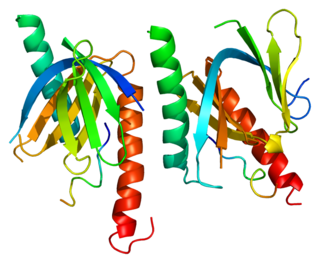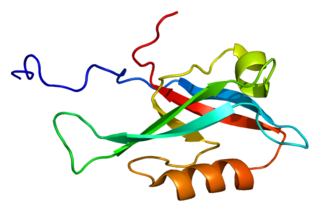Erbb2 interacting protein (ERBB2IP), also known as erbin, is a protein which in humans is encoded by the ERBB2IP gene. [5] Discovered in 1997, erbin is a 200kDa protein containing a PDZ domain. [6]
Erbb2 interacting protein (ERBB2IP), also known as erbin, is a protein which in humans is encoded by the ERBB2IP gene. [5] Discovered in 1997, erbin is a 200kDa protein containing a PDZ domain. [6]
This gene is a member of the leucine-rich repeat and PDZ domain (LAP) family. The encoded protein contains 17 leucine-rich repeats and one PDZ domain. It binds to the unphosphorylated form of the ERBB2 protein and regulates ERBB2 function and localization. It has also been shown to affect the Ras signaling pathway by disrupting Ras-Raf interaction. Alternate transcriptional splice variants encoding different isoforms have been found for this gene, but only two of them have been characterized to date. [5]
Erbin's C-terminal PDZ domain is able to bind to ErbB2, a protein tyrosine kinase which is often associated with poor prognosis in epidermal oncogenesis. [7] Erbin's N-terminal region has been shown to disrupt Ras to Raf binding and may be, through this action, a tumor suppressing protein. [8]
Erbin has been shown to interact with:

Receptor tyrosine-protein kinase erbB-2, also known as CD340, proto-oncogene Neu, Erbb2 (rodent), or ERBB2 (human), is a protein that in humans is encoded by the ERBB2 gene. ERBB is abbreviated from erythroblastic oncogene B, a gene isolated from avian genome. It is also frequently called HER2 or HER2/neu.

Sodium-hydrogen antiporter 3 regulator 1 is a regulator of Sodium-hydrogen antiporter 3. It is encoded by the gene SLC9A3R1. It is also known as ERM Binding Protein 50 (EBP50) or Na+/H+ Exchanger Regulatory Factor (NHERF1). It is believed to interact via long-range allostery, involving significant protein dynamics.

Peripheral plasma membrane protein CASK is a protein that in humans is encoded by the CASK gene. This gene is also known by several other names: CMG 2, calcium/calmodulin-dependent serine protein kinase 3 and membrane-associated guanylate kinase 2.

Protein Interacting with C Kinase - 1 is a protein that in humans is encoded by the PICK1 gene.

Syntenin-1 is a protein that in humans is encoded by the SDCBP gene.

GIPC PDZ domain containing family, member 1 (GIPC1) is a protein that in humans is encoded by the GIPC1 gene. GIPC was originally identified as it binds specifically to the C terminus of RGS-GAIP, a protein involved in the regulation of G protein signaling. GIPC is an acronym for "GAIP Interacting Protein C-terminus". RGS proteins are "Regulators of G protein Signaling" and RGS-GAIP is a "GTPase Activator protein for Gαi/Gαq", which are two major subtypes of Gα proteins. The human GIPC1 molecule is 333 amino acids or about 36 kDa in molecular size and consists of a central PDZ domain, a compact protein module which mediates specific protein-protein interactions. The RGS-GAIP protein interacts with this domain and many other proteins interact here or at other parts of the GIPC1 molecule. As a result, GIPC1 was independently discovered by several other groups and has a variety of alternate names, including synectin, C19orf3, RGS19IP1 and others. The GIPC1 gene family in mammals consisting of three members, so the first discovered, originally named GIPC, is now generally called GIPC1, with the other two being named GIPC2 and GIPC3. The three human proteins are about 60% identical in protein sequence. GIPC1 has been shown to interact with a variety of other receptor and cytoskeletal proteins including the GLUT1 receptor, ACTN1, KIF1B, MYO6, PLEKHG5, SDC4/syndecan-4, SEMA4C/semaphorin-4 and HTLV-I Tax. The general function of GIPC family proteins therefore appears to be mediating specific interactions between proteins involved in G protein signaling and membrane translocation.

Amyloid beta A4 precursor protein-binding family A member 1 is a protein that in humans is encoded by the APBA1 gene.

Na(+)/H(+) exchange regulatory cofactor NHE-RF3 is a protein that in humans is encoded by the PDZK1 gene.

Amyloid beta A4 precursor protein-binding family A member 2 is a protein that in humans is encoded by the APBA2 gene.

Serine/threonine-protein kinase N2 is an enzyme that in humans and Strongylocentrotus purpuratus is encoded by the PKN2 gene.

InaD-like protein is a protein that in humans is encoded by the PATJ gene.

Plakophilin-4 is a protein that in humans is encoded by the PKP4 gene.

Beta-1-syntrophin is a protein that in humans is encoded by the SNTB1 gene.

Glutamate receptor-interacting protein 1 is a protein that in humans is encoded by the GRIP1 gene.

Disks large-associated protein 1 (DAP-1), also known as guanylate kinase-associated protein (GKAP), is a protein that in humans is encoded by the DLGAP1 gene. DAP-1 is known to be highly enriched in synaptosomal preparations of the brain, and present in the post-synaptic density.

SH3 and multiple ankyrin repeat domains protein 1 is a protein that in humans is encoded by the SHANK1 gene.

Lin-7 homolog A is a protein that in humans is encoded by the LIN7A gene.

PDZ domain-containing protein 2 is a protein that in humans is encoded by the PDZD2 gene.

Poliovirus receptor-related 3 (PVRL3), also known as nectin-3 and CD113, is a human protein of the immunoglobulin superfamily which forms part of adherens junctions.

Fms-related tyrosine kinase 4, also known as FLT4, is a protein which in humans is encoded by the FLT4 gene.